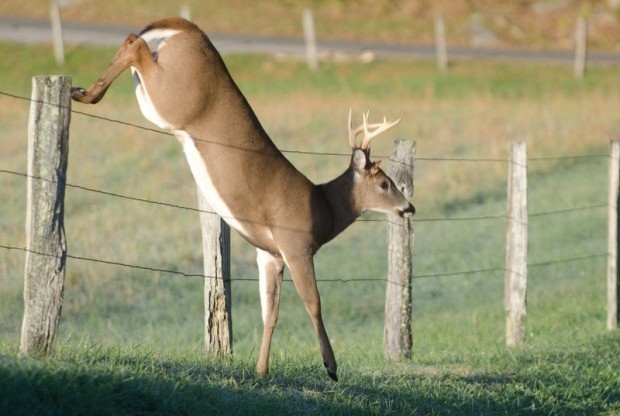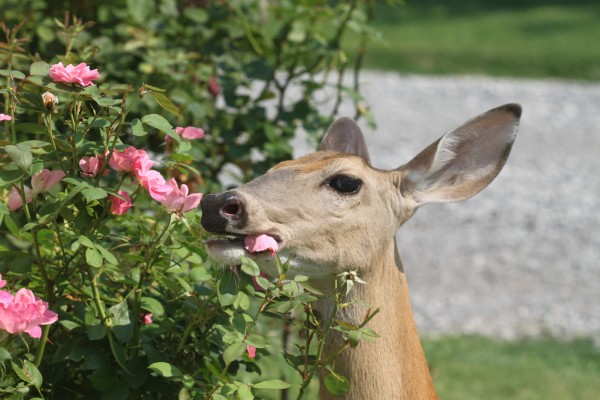How To Keep Deer Out Of Your Garden

Completely effective deer fence, lol
Seeing a deer in the wild can be an exciting experience, but seeing one in your garden… not so much. If you live near a forested area where deer live, the novelty of these animals quickly wears off and that’s why you’re here looking for a way to keep deer out of your garden.
To them, your garden looks like an all-you-can-eat buffet, which means that even a single deer can completely decimate your garden (including trampling it).
To keep your garden safe, you need to figure out ways that will effectively keep deer out without needing to create a completely enclosed greenhouse. There are many different options out there and some may work well for your particular situation, while others might not. Here are a few key approaches that you can try to make sure deer munch on wild plants instead of the ones you’re growing.
Frighten Them Away
Deer have a number of natural predators, so they always have to be alert. You can use this to your advantage by using approaches that can scare them off.
A good way of doing this is sudden noises. For example, there are some devices you can get that make ultrasonic noises that deer can hear that keeps them away. The devices operate at a frequency that humans can’t hear (similar to a dog whistle).
Simpler noise deterrents can also be used. For example, stringing up cans or pie pans to rattle in the wind can create a sudden sound that can be alarming to deer.
Another noise-based deterrent is if you have a dog that will bark at the deer. Careful with dogs though, because they can run off after the deer, or even start fighting with it. If you’ve never seen a deer and a dog fight, the dog pretty much loses all the time. Plus, this isn’t a very practical solution for people who don’t have a dog or don’t want one.
You can also use scarecrows or stringers to try and frighten deer. Things that move in the wind are good approaches as the movement can catch the attention of the deer and frighten them. Shiny objects that catch the light will be more easily seen and probably have a bigger effect, at least during the day.
Hey, even a sneeze works!
There is a catch though!
Deer are intelligent animals and they do learn patterns. This means that any attempt to frighten deer away has to be changed around periodically. Otherwise, the deer will simply get used to the noise or the movement and ignore it. This is especially true in urban settings, as the deer are already used to tuning out the noises of the city.
Motion Sensor Sprinklers
One great combination of both noise and physical shock is using a motion sensor sprinkler in your yard. There are hose-connected models for gardening areas close to the house (within reach of a hose), and reservoir models that work from a tank that you can place further out. You can also buy hose connectors to extent your hoses since the tank models may need to be filled each day for high traffic areas.
Motion sensor sprinklers work well for one, because they are noisy. I has some place in my front yard for a few months, and I would forget about them, then get a bit spooked when I walked to my car. Imaging how scared a deer will be in the middle of the night!
The other thing that works in your favor is that they actually shoot water at the deer. Water is harmless, so it won’t cause any physical harm, but a cold spray from a garden hose is enough to send anyone (human or animal) running.
This has the added benefit of working against all forest creatures, including raccoons, foxes, and more. You can see my #1 recommend motion sensor sprinkler here or see the full list of sprinkler reviews here.
Repel Them With Taste or Smell
Repellants based on smell or taste can be a good way of stopping deer from getting into your garden. You can buy repellants that are already made or make your own. One common type of repellant uses the smell of sulfur, which is a smell that deer tend to avoid.
You can apply repellants to leaf surfaces or use repellants that work to create a perimeter around your garden. Of these two methods, applying the repellants to the leaves directly is more effective, although it is also more time-consuming and resource-intensive. If it rains, you may be out of luck and have to reapply after the repellant washes away.
You also want to be careful about applying any repellant directly to herbs and vegetables that you plan on eating, as you may end up making your food inedible. If you have other pets in your yard, you also want to be careful that this won’t have an affect on their health, or any kids that may touch the pets after they play outside.
Plants Undesirable Things
Deer see gardens as food sources and they particularly love plants that are easy to eat. Because of this you can keep deer out of your garden by planting things that they find unappealing.
Some examples of plants that deer don’t particularly like are butterfly weed, chrysanthemums, rosemary and lily-of-the-valley. You can also look out for any plants that have natural defenses, such as thorns or plants that have leathery or fuzzy leaves.
However, it is important to note that there are few plants that are entirely deer-proof. Like most animals, deer do tend to be unpredictable. They will also get much less picky about what they eat when they are very hungry, so you might still find them nibbling at your garden sometimes.

This doe has no problem munching on some thorny roses
Completely Block Them Out
The single-most effective way to keep deer out of your garden is to make it so they physically can’t get in. If you can block deer out physically then you don’t have to worry about whether or not they will avoid your plants.
To achieve this, you really need to have a fence that is at least 7-feet tall so the deer don’t simply jump over the fence. The most effective type of fence is a privacy fence, because this means that the deer can’t see the garden either, which makes it less appealing.
An alternative (less expensive) approach is to use deer netting, this can create a less permanent fence that is still effective at keeping deer out. If you’re going with a netting approach, hanging streamers on the fence can help deer to know the fence is there and they don’t get caught in the material. They have poor vision and may simply try to run through the fence anyway if you don’t do this.
I also found this YouTube video with a pretty good idea (and it’s simple). It’s much more practical than building a 7 foot fence around your garden, and seems to have worked pretty well for this guy over the years.
Categorised in: Animals
